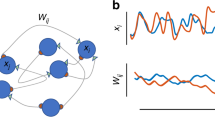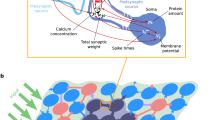Abstract
Memories maintained in patterns of synaptic connectivity are rapidly overwritten and destroyed by ongoing plasticity related to the storage of new memories. Short memory lifetimes arise from the bounds that must be imposed on synaptic efficacy in any realistic model. We explored whether memory performance can be improved by allowing synapses to traverse a large number of states before reaching their bounds, or by changing the way these bounds are imposed. In the case of hard bounds, memory lifetimes grow proportional to the square of the number of synaptic states, but only if potentiation and depression are precisely balanced. Improved performance can be obtained without fine tuning by imposing soft bounds, but this improvement is only linear with respect to the number of synaptic states. We explored several other possibilities and conclude that improving memory performance requires a more radical modification of the standard model of memory storage.
This is a preview of subscription content, access via your institution
Access options
Subscribe to this journal
Receive 12 print issues and online access
$209.00 per year
only $17.42 per issue
Buy this article
- Purchase on Springer Link
- Instant access to full article PDF
Prices may be subject to local taxes which are calculated during checkout





Similar content being viewed by others
References
Bliss, T.V. & Collingridge, G.L. A synaptic model of memory: long-term potentiation in the hippocampus. Nature 361, 31–39 (1993).
Bredt, D.S. & Nicoll, R.A. AMPA receptor trafficking at excitatory synapses. Neuron 40, 361–379 (2003).
Amit, D.J. Modeling Brain Function (Cambridge University Press, New York, 1989).
Hertz, J., Krogh, A. & Palmer, R.G. Introduction to the Theory of Neural Computation (Addison Wesley Longman, Boston, 1991).
Amit, D.J. & Fusi, S. Constraints on learning in dynamic synapses. Network 3, 443–464 (1992).
Amit, D.J. & Fusi, S. Learning in neural networks with material synapses. Neural Comput. 6, 957–982 (1994).
Fusi, S. Hebbian spike-driven synaptic plasticity for learning patterns of mean firing rates. Biol. Cybern. 87, 459–470 (2002).
Staubli, U. & Lynch, G. Stable depression of potentiated synaptic responses in the hippocampus with 1–5 Hz stimulation. Brain Res. 513, 113–118 (1990).
Larson, J., Xiao, P. & Lynch, G. Reversal of LTP by theta frequency stimulation. Brain Res. 600, 97–102 (1993).
O'Dell, T.J. & Kandel, E.R. Low-frequency stimulation erases LTP through an NMDA receptor–mediated activation of protein phosphatases. Learn. Mem. 1, 129–139 (1994).
Xiao, M.Y., Niu, Y.P. & Wigstrom, H. Activity-dependent decay of early LTP revealed by dual EPSP recording in hippocampal slices from young rats. Eur. J. Neurosci. 8, 1916–1923 (1996).
Zhou, Q., Tao, H.W. & Poo, M-m. Reversal and stabilization of synaptic modifications in a developing visual system. Science 300, 1953–1957 (2003).
Barnes, C.A. Memory deficits associated with senescence: a neurophysiological and behavioral study in the rat. J. Comp. Physiol. Psychol. 93, 74–104 (1979).
Ahissar, E. et al. Dependence of cortical plasticity on correlated activity of single neurons and on behavioral context. Science 257, 1412–1415 (1992).
Manahan-Vaughan, D. & Braunewell, K.H. Novelty acquisition is associated with induction of hippocampal long-term depression. Proc. Natl. Acad. Sci. USA 96, 8739–8744 (1999).
Fu, Y.-X. et al. Temporal specificity in the cortical plasticity of visual space representation. Science 296, 1999–2003 (2002).
Xu, L., Anwyl, R. & Rowan, M.J. Spatial exploration induces a persistent reversal of long-term potentiation in rat hippocampus. Nature 394, 891–894 (1998).
Abraham, W.C., Logan, B., Greenwood, J.M. & Dragunow, M. Induction and experience-dependent consolidation of stable long-term potentiation lasting months in the hippocampus. J. Neurosci. 22, 9626–9634 (2002).
Villarreal, D.M., Do, V., Haddad, E. & Derrick, B.E. NMDA receptor antagonists sustain LTP and spatial memory: active processes mediate LTP decay. Nat. Neurosci. 5, 48–52 (2002).
Jenkins, J. & Dallenbach, K. Oblivescence during sleep and waking period. Am. J. Psychol. 35, 605–612 (1924).
Brown, M.W. & Xiang, J.Z. Recognition memory: neuronal substrates of the judgement of prior occurrence. Prog. Neurobiol. 55, 149–189 (1998).
Wixted, J.T. & Ebbesen, E.B. Genuine power curves in forgetting: a quantitative analysis of individual subject forgetting functions. Mem. Cognit. 25, 731–739 (1997).
Bi, G.-Q. & Poo, M.-M. Synaptic modifications in cultured hippocampal neurons: dependence on spike timing, synaptic strength, ad postsynaptic cell type. J. Neurosci. 18, 10464–10472 (1998).
Parisi, G. A memory which forgets. J. Phys. A. 19, L617–L620 (1986).
Fusi, S., Drew, P.J. & Abbott, L.F. Cascade models of synaptically stored memories. Neuron 45, 599–611 (2005).
Brunel, N., Carusi, F. & Fusi, S. Slow stochastic Hebbian learning of classes of stimuli in a recurrent neural network. Network 9, 123–152 (1998).
Fusi, S. & Senn, W. Eluding oblivion with smart synaptic updates. Chaos 16, 026112 (2006).
Kahn, P.E., Wong, K.Y.M. & Sherrington, D. A memory model with novel behaviour in sequential learning. Network. Comput. Neural Sys. 6, 415–427 (1995).
van Rossum, M.C., Bi, G.Q. & Turrigiano, G.G. Stable Hebbian learning from spike timing-dependent plasticity. J. Neurosci. 20, 8812–8821 (2000).
Rubin, J.E. Steady states in an iterative model for multiplicative spike-timing dependent plasticity. Network 12, 131–140 (2001).
Gutig, R., Aharonov, R., Rotter, S. & Sompolinsky, H. Learning input correlations through nonlinear temporally asymmetric Hebbian plasticity. J. Neurosci. 23, 3697–3714 (2003).
Festa, R. & Galleani D'Agliano, E. Diffusion coefficient for a brownian particle in a periodic field of force. Physica A 90A, 229–244 (1978).
Petersen, C.C., Malenka, R.C., Nicoll, R.A. & Hopfield, J.J. All-or-none potentiation at CA3–CA1 synapses. Proc. Natl. Acad. Sci. USA 95, 4732–4737 (1998).
O'Connor, D.H., Wittenberg, G.M. & Wang, S.S.-H. Graded bidirectional synaptic plasticity is composed of switch-like unitary events. Proc. Natl. Acad. Sci. USA 102, 9679–9684 (2005).
O'Connor, D.H., Wittenberg, G.M. & Wang, S.S.-H. Dissection of bidirectional synaptic plasticity into saturable unidirectional processes. J. Neurophysiol. 94, 1565–1573 (2005).
Montgomery, J.M. & Madison, D.V. Discrete synaptic states define a major mechanism of synapse plasticity. Trends Neurosci. 27, 744–750 (2004).
Scoville, W.B. & Milner, B. Loss of recent memory after bilateral hippocampal lesions. J. Neurol. Neurosurg. Psychiatry 20, 11–21 (1957).
Chklovskii, D.B., Mel, B.W. & Svoboda, K. Cortical rewiring and information storage. Nature 431, 782–788 (2004).
Willshaw, D.J., Buneman, O.P. & Longuet-Higgins, H.C. Non-holographic associative memory. Nature 222, 960–962 (1969).
Grossberg, S. Processing of expected and unexpected events during conditioning and attention: a psychophysiological theory. Psychol. Rev. 89, 529–572 (1982).
Rosenblatt, F. The perceptron: a probabilistic model for information storage and organization in the brain. Psychol. Rev. 65, 386–408 (1958).
Block, H. The perceptron: a model for brain functioning. I. Rev. Mod. Phys. 34, 123–135 (1962).
Minsky, M.L. & Papert, S.A. Perceptrons (MIT Press, Cambridge, Massachusetts, 1969; expanded edition, 1988).
Tsodyks, M.V. & Feigelman, M.V. The enhanced storage capacity in neural networks with low activity level. Europhys. Lett. 6, 101–105 (1988).
Tsodyks, M.V. Associative memory in neural networks with binary synapses. Mod. Phys. Lett. B B4, 713–716 (1990).
Abraham, W.C. & Bear, M.F. Metaplasticity: the plasticity of synaptic plasticity. Trends Neurosci. 19, 126–130 (1996).
Fischer, T.M., Blazis, D.E., Priver, N.A. & Carew, T.J. Metaplasticity at identified inhibitory synapses in Aplysia. Nature 389, 860–865 (1997).
Montgomery, J.M. & Madison, D.V. State-dependent heterogeneity in synaptic depression between pyramidal cell pairs. Neuron 33, 765–777 (2002).
Acknowledgements
We are grateful to M. Mattia for useful discussions about Brownian particles in periodic potentials. This research was supported by US National Institute of Mental Health grant 58754 and by a US National Institutes of Health Director's Pioneer Award, part of the NIH Roadmap for Medical Research, through grant number 5-DP1-OD114-02.
Author information
Authors and Affiliations
Corresponding author
Ethics declarations
Competing interests
The authors declare no competing financial interests.
Supplementary information
Rights and permissions
About this article
Cite this article
Fusi, S., Abbott, L. Limits on the memory storage capacity of bounded synapses. Nat Neurosci 10, 485–493 (2007). https://doi.org/10.1038/nn1859
Received:
Accepted:
Published:
Issue Date:
DOI: https://doi.org/10.1038/nn1859
This article is cited by
-
Randomly fluctuating neural connections may implement a consolidation mechanism that explains classic memory laws
Scientific Reports (2022)
-
Filopodia are a structural substrate for silent synapses in adult neocortex
Nature (2022)
-
Drifting neuronal representations: Bug or feature?
Biological Cybernetics (2022)
-
Energetics of stochastic BCM type synaptic plasticity and storing of accurate information
Journal of Computational Neuroscience (2021)
-
Remembrance of things practiced with fast and slow learning in cortical and subcortical pathways
Nature Communications (2020)



